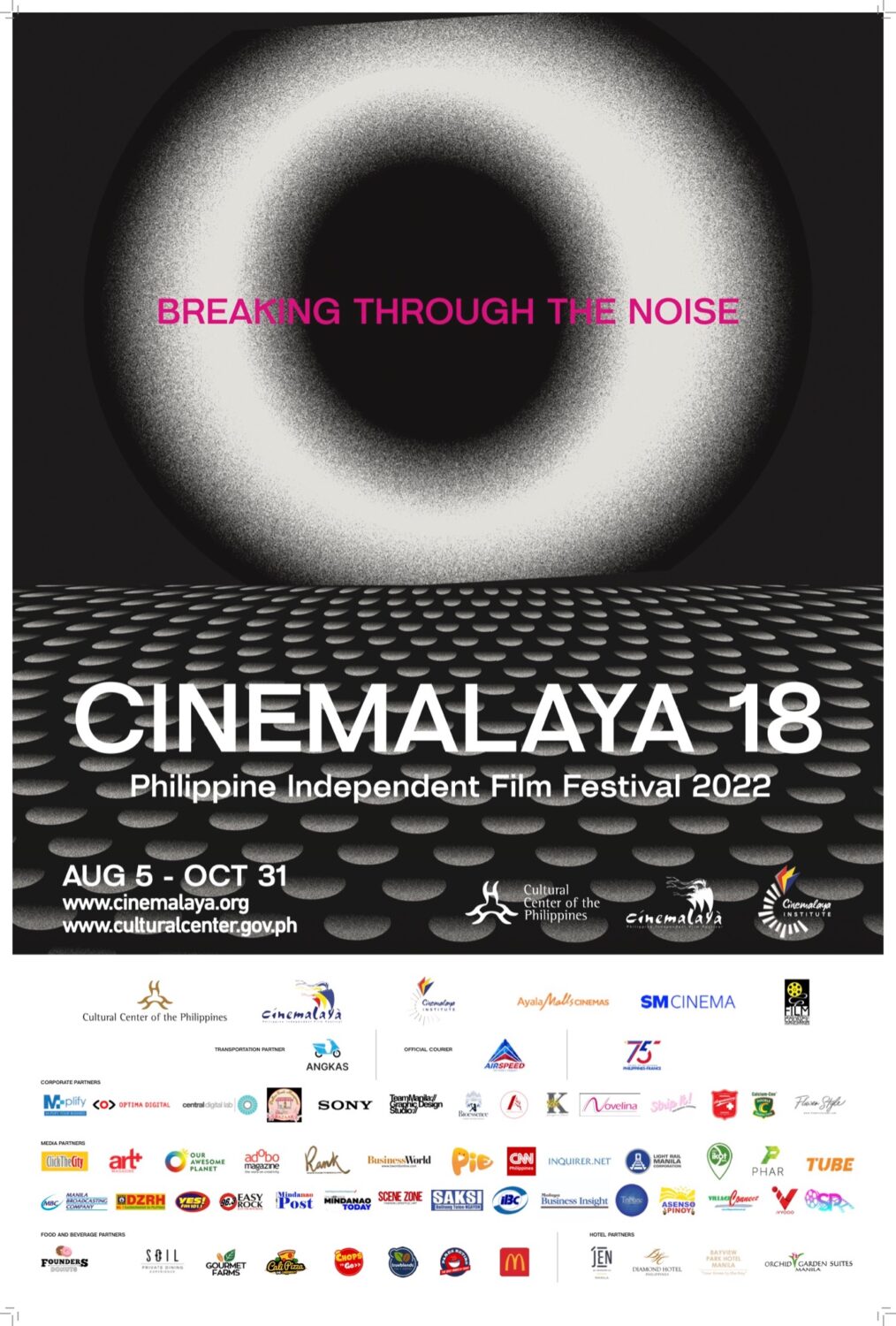The biggest and most highly-anticipated independent film festival in our country, Cinemalaya, has been producing and screening films for more than eighteen years and it has maintained a reputation for providing its audience with top-notch movies that everyone should see while serving as the breeding ground of some of the most respectable local filmmakers.
Following two year of taking the online space, this year, the festival resumes playing films at the Cultural Center of the Philippines, to the excitement and delight of its faithful supporters in its 18 years. With the 2022 theme “Breaking the Noise”, Cinemalaya returns to Tanghalang Nicanor Abelardo (CCP Main Theater), Tanghalang Huseng Batute (CCP Studio Theater), and Tanghalang Manuel Conde (CCP Arthouse Cinema) as these venues lift their red curtains again to show a variety of films.
In an exclusive, Chris Millado, Festival Director tells Rank Magazine the intricate history of how Cinemalaya was founded, the festival’s journey, and how it rebuilt and transformed the Filipino film industry.
Since Cinemalaya was established in 2005, its single focus has been to resurrect the faltering Filipino film industry. The festival was supposed to take place once every two years initially. The response to the first edition was so surprising that they decided to continue the festival the next year, and the rest is history. 18 long years later, the festival has continued on to give birth not just to some of the biggest cinematic gems that the Philippine filmmaking industry has seen, but talented filmmakers to command a second look from the global film scene.
“I would give it to the visionaries who started Cinemalaya and that would be Laurice Guillen, the Film Development Council of the Philippines, Nes Jardin, Tonyboy Cojuangco, who really saw the need for it, and I think that was the objective, to really revive what was then, talagang naghihingalo na film industry in the Philippines,” Millado opens.
“I didn’t know that it would catch up so quickly, they thought it would happen pa in the next three to five years but in the first edition ng Cinemalaya more than eighteen years ago, they were planning to do Cinemalaya lang once every two years, but because of the response of the very first edition, they decided immediately to do it the next year and the growth of the content in terms of filmmakers who came out of the woodwork, wanted to be part of it as well as the growth of the audiences became exponential after the third edition, to that it continued to expand up to today.”
There are things that have changed along the way as the Cinemalaya progressed from simply revitalizing the industry to building something that no one could have ever dreamed. The festival created a space not just for Filipino filmmakers but also to its audience.
“Cinemalaya as a festival and [the] people behind it stubbornly held on to the belief that the story telling should be driven by the vision of the director and the filmmakers not by the so called ‘market’. So, with that belief I think that practically defined Cinemalaya as this platform for new, daring, uniquely original voices.”
“Cinemalaya came at the right time at the cusp when digital filmmaking was being introduced which made production very accessible, production was transferred to the hands of practically almost everyone who knows how to operate a digital camera.”
He continues, “From then on, the cost of production, because of the revolutionizing of the methods of production from cameras to digital application for editing and so and so forth, it became accessible to content creators. The entry for being the filmmaker became more accessible to more people, especially young filmmakers. It became much more in depth in terms of these new technologies. Third, audiences became very receptive to more content because of the proliferation of the internet, media, their taste became more broader, more international, more cosmopolitan, because when you go online you have more access to a multitude and to really diverse content not only in the Philippine but all over the world, in a way this prepared the audiences for a bit more diverse kind of content and storytelling.”
The way that the film industry was revived back then reflected what’s happening in today’s edition of the festival because of the setbacks that the pandemic had created. “Cinemalaya jumpstarted the industry again, and at the core of it was new voices and new content because apparently audiences then are getting tired of the same fare that they’re getting from the big studios, so they sort of lost their interest then in the same thing.”
Millado connects this to the present, “Because of the pandemic, same thing happened, not because the people are getting tired of it, on our Cinemalaya 2019, we were already leading up to breaking our records in Cinemalaya, then the pandemic happened and as you know, the whole industry, not only in the Philippines but in the whole world, was practically shut down and now, we emerge from it again and Cinemalaya again was trying to jumpstart everything.”
Despite the pandemic slowing down the film industry on a global scale, Cinemalaya has learned a lot from it that helped them to become better. “The first is distribution, that has always been the weakness of Cinemalaya, because you must remember that you know in the festival, we have that excitement we have thousands of people trouping to the CCP but if you look at the number of mass audiences that we’re supposed to reach we’re barely a fraction and we’re only actually reaching audiences in Metro Manila, Cinemalaya, the brand is not known in the regions they don’t know what Cinemelaya is.”
“So, there’s still this continuing challenge about distribution and making Cinemalaya more accessible to audiences outside of Manila and even outside of the Philippines. Second, we’re looking at screening rights. In the past years, we’ve been very strict about Cinemalaya owning the screening rights for two years after its shown, but during the pandemic, the organization sort of stopped that rule, in recognition of the hardship that the pandemic brought about and in recognition of the fact that there is indeed potential in having these films being screened in others places besides just Cinemalaya-owned platforms. We’ve reviewed that, we’ve aced that up and Cinemalaya has been more generous to the filmmakers with regards that.”
As a result of the learning that the pandemic has brought, Cinemalaya 18 is presently using a hybrid form of screening that can reach a larger audience than it could previously, given that the filmmakers are not just from Manila but also from other places in the region.
Millado furthers, “This year we have eleven full length films in competition, we have twelve short films in competition, and of course, we have our opening film and our closing films-and we have two this year. I think, one of the very exciting characteristics of this batch of filmmakers, especially in the short film section, that only two out of this twelve short filmmakers come from Metro Manila, the rest comes from the region. Immediately, this is an indicator of the kind of scene that is emerging in the region that it’s no longer just the territory of Manila-based filmmakers.”
As has already been announced, Cinemalaya 18 marks the longest and widest reach for films in competition in its almost two-decades-long history. In addition to the standard CCP screening, there will be commercial, regional, campus screening, and online screenings.
“This year’s edition was characterized by the focus on the competition films, its characterized by more participation of filmmakers coming from the regions, and this is going to be the longest spread of the festival, its no longer just at the CCP.” Characterized with different language and identity, the eleven full-length film and the twelve short films that everyone should see in the film festival are:
Full-Length Films
- THE BASEBALL PLAYER by Carlo Obispo
- RETIRADA by Cynthia Cruz-Paz and Milo Alto Paz
- KARGO by TM Malones
- KALUSKOS by Roman Perez Jr.; Screenplay by Enrique Villasis
- GINHAWA by Christian Paolo Lat
- BULA SA LANGIT by Sheenly Gener; Screenplay by Andrian Legaspi
- BLUE ROOM by Ma-an L. Asuncion-Dagnalan
- BATSOY by Ronald Espinosa Batallones
- BAKIT DI MO SABIHIN? by Real Florido; Screenplay by Floriza Ferrer
- ANGKAS by Rain Yamson; Screenplay by Jaymar Santos Castro
- 12 WEEKS by Anna Isabelle Matutina
Short Films
- AMPANGABAGAT NIN TALAKBA HA LIKOL (IT’S RAINING FROGS OUTSIDE) by Maria Estela Paiso
- BLACK RAINBOW by Zig Dulay
- CITY OF FLOWERS by Xeph Suarez
- DIKIT by Gabriela Serrano
- DISTANCE by Dexter Paul De Jesus
- DUWA-DUWA by Nena Jane Achacoso
- KWITS by Raz De La Torre
- MATA KANG BUSAY (VISION OF THE FALLS) by Niño Maldecir & Cyphor John Gayorgor
- MGA HANDUM NGA NASULAT SA BARAS (THE DREAMS THAT ARE WRITTEN IN THE SAND) by Arlie Sweet Sumagaysay& Richard JerouiSalvadico
- ROUNDTRIP TO HAPPINESS by Claudia Fernando
- SEE YOU, GEORGE! by Mark Moneda
- SI ODDIE by Maria KydyleeTorato
When asked of the future of the pioneering independent film festival, Millado paints a picture of the possibility of it becoming traveling festival. While far from this concept becoming a discussion, more so landing on the drawing board of the institution, the festival director see this in the foreseeable future, a fulfillment of Cinemalaya ultimately living up to its name as a Philippine independent film festival, not just centered on the capital.
Despite the experience the audience received from the festival, the live showing of outstanding Filipino films at a historically significant setting full of arts and culture may not happen in the next few years due to CCP’s impending redevelopment. To date, only three of the usual screening venues within the CCP premises are being used.
That said, although the traditional Cinemalaya may possibly be coming to a bittersweet end at its home at the CCP’s historic locations, for Millado, this is a perfect opportunity for the festival to spread outside the metro and become a national celebration.
Millado highlights, “I think now Cinemalaya [may be] forced to look at a model wherein we still retained that sense of big cinema, but at the same time, leads into the best characteristics of simultaneity, especially with the digital technology and the digital cinemas. And maybe it’s time to call in and say, ‘Okay, this city in the region would you like to host the awards ceremonies of Cinemalaya?’ and then all filmmakers and audiences might just consider flying in and being part of that whole big festival, it will call attention to your city as well as it will call attention to Cinemalaya in that part of the Philippines.”
All of these changes and difficulties have us wondering why Cinemalaya keeps going despite everything. “Cinemalaya persists because the filmmakers persist. Without a filmmaker, I don’t think Cinemalaya will be there. It is because they were persistent so that is why the festival endured, if we didn’t have our hardy, brave, persistent stubborn filmmakers, Cinemalaya wouldn’t have survived the whole pandemic either.”
The festival is continuing to flourish and making its imprint on the cinema industry, no small thanks to all of the Cinemalaya visionaries, filmmakers, and actors that fueled its 18 year tradition. “I think the Cinemalaya legacy is providing the space for these young, inexperienced filmmakers to realize his/her story. It’s allowing a new breed of storytellers to tell their story with their original vision unhampered by commercialism.”
The festival’s 18th year showcased the hard work and commitment of people who made movies during those years as well as the festival as a whole. It demonstrates how the movie stokes every Filipino filmmaker’s desire to make movies using the platform Cinemalaya provided them with, as well as how it expands Filipinos’ appreciation for homegrown movies.
The legacy they have created and are still creating will sprout up like a seed for the following generations to see and experience. Cinemalaya not only brought the Filipino film industry back to life, but it also helped to forge a community and a culture in which every Filipino should take pride.

Cinemalaya 18 will run From August 5 – October 31, 2022. To purchase tickets for the festival visit CCP Box Office, for the Commercial screenings visit Ticketworld and SM Tickets or head to the official Cinemalaya social media accounts on Facebook and Instagram or the festival’s official website for more information.
Rank Magazine is an official media partner of Cinemalaya 18.


